|
Transportation Research Update
 Pedestrian Experience at Roundabouts
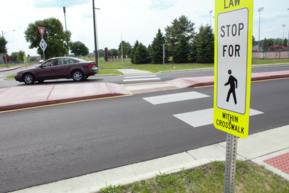
TRAFFIC AND SAFETY - What is it like for pedestrians to cross the road at a roundabout? After an initial survey of city and county engineers and other experts, fifteen roundabouts were selected for observation using multiple cameras at each roundabout. Another eight roundabouts were subject to in-depth analysis of the pedestrian user experience. Study findings show that when compared to multi-lane roundabouts, single-lane roundabouts performed well in terms of driver vehicle-yielding rates toward pedestrians. Use of rectangular rapid flashing beacons (RRFBs) at pedestrian crossings has shown better driver-yielding rates while in-roadway signs have shown satisfactory results. Chapter five of the report serves as a guidance document to help city and county engineers enhance pedestrian user experience at Minnesota roundabouts.
|
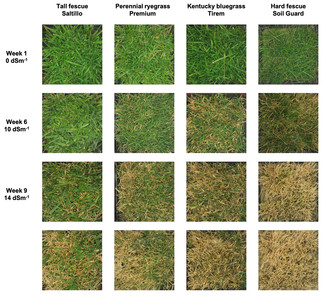
Roadside turfgrass is necessary for stabilizing the roadway, preventing erosion and filtering stormwater runoff. Maintaining it can be challenging in Minnesota’s harsh climate. Deicing salt, snowplow damage, summer heat and drought can prevent vegetation from thriving. Local agencies need cost-effective, successful seed mixes to ensure optimal roadside grass coverage.
Fourteen roadside sites around the state were planted with 120 plots each to test seed mixes and growing environments. After analyzing the soil, weeds and grass coverage over two growing seasons, researchers found that mixes with multiple grass species were most successful in providing consistent coverage. Region-specific turfgrass seed mixes were recommended based on climate and soil quality. Additionally, a cost estimation tool was developed to help local agencies be confident in their roadside vegetation choices. The Local Road Research Board will continue to explore the best climate-resilient grass species and refine cost tools with more data and greater usability.
|
Effective Placement of High-Tension Cable Median Barriers

TRAFFIC AND SAFETY - High-tension cable barriers have reduced serious crashes caused when a vehicle crosses the median. MnDOT suspected the effectiveness of the barriers in reducing all types of crashes depends on the distance the barrier is from the road’s edge. While cable barriers are less costly than those made of concrete, all material costs have risen substantially, and changing a median design or regrading slopes to accommodate appropriately placed cable barriers may add significant cost. New research has given MnDOT a method to quantify the relationship between the frequency of crashes and the distance from the road’s edge to the barrier. The costs of placing new cable barrier, moving existing barrier and implementing more extensive projects like regrading or widening medians can be compared to corresponding changes in crashes, allowing MnDOT to understand the relative value of the alternatives.
|
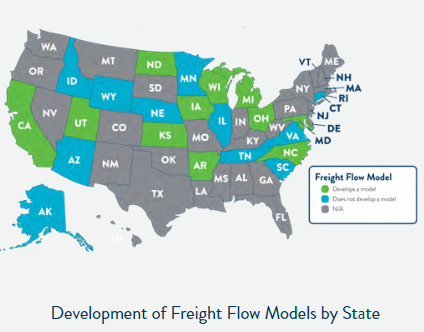
MULTIMODAL - Minnesota’s economy is dependent on the safe and efficient transport of freight, whether by truck, train, boat, airplane or pipeline. The state’s transportation network provides the physical framework for this commerce. MnDOT needs accurate data on the type, destination and quantity of cargo that is being transported to ensure the infrastructure’s capacity is sufficient to handle freight needs. Current freight data sets are limited, however, in the extent and specificity of information. New research will help to fill these gaps, ensure supply chain disruptions are minimized and help MnDOT plan better freight transportation investments.
Researchers analyzed the freight data landscape across the United States, including the variety of public and private databases, efforts to model freight flow and other state practices. They explored commonly used public and proprietary databases and several software and modeling tools, identifying advantages and weaknesses of each. A survey and nine in-depth case studies led to a baseline of existing freight data resources, recommendations for generating and collecting freight data, and an understanding of freight data needs across the state, summarized in a Freight Data Infographic.
This project also informed MnDOT’s plan to develop a tool that will lead to an efficient multimodal network for moving goods around the state and lowering supply chain costs.
|
Investigating Max-Pressure Traffic Signal Timing
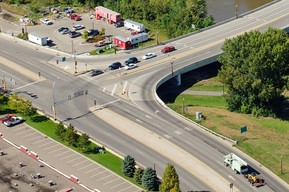
TRAFFIC AND SAFETY - A new signal timing method, max-pressure signal control, detects entire vehicle queues waiting to cross and exit an intersection and uses a mathematically proven algorithm to maximize the number of vehicles moving through to minimize delays. It has great promise to make traffic signals more adaptive to real-time traffic, creating a more efficient traffic management system and minimizing delay. Simulations show that some issues need to be resolved before it can be implemented however. In this study, the original model assumed there were separate turn lanes and did not limit maximum wait times when traffic was light. This could result in drivers or pedestrians waiting long periods of time before crossing. Researchers modified this model and simulated its performance using data and parameters from intersections in Hennepin County. The result projected significantly reduced delays and more traffic moving through the intersections as compared to the current signal controls. The next step will be to test the max-pressure system with the county’s existing equipment to determine what is needed to deploy the traffic signals.
|
TRB Annual Meeting in Washington, D.C.
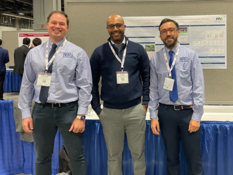
Earlier this year, we joined thousands of transportation administrators, practitioners, policy makers, and researchers at the 2023 TRB Annual Meeting in Washington, D.C. MnDOT staff presented their work in more than 39 sessions. We had a wonderful time sharing, learning, and connecting with so many of you!
|
|
|
|
MnDOT invites and encourages participation by all people in their programs, services and activities.
If you need an ASL, a foreign language interpreter, or documents in an alternative format (such as braille, large print or in a different language) at no cost, please email your request to Janet Miller at ADArequest.dot@state.mn.us or call 651-366-4720. Relay service: 711.
If you need any other reasonable accommodation to participate (such as seating modification or auxiliary aids), please email your request to Accessibility.DOT@state.mn.us or call 1-833-400-8432. Relay service: 711.
|
|
|
|
|